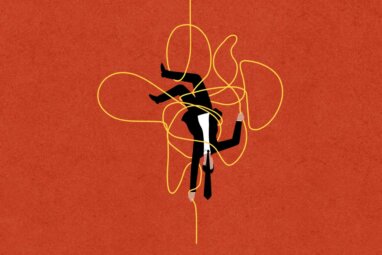The Five Steps All Leaders Must Take in the Age of Uncertainty
Corporate executives need to move beyond only managing their own company and become active influencers within broader systems.
Business leaders increasingly find themselves in unfamiliar territory marked by high levels of uncertainty and instability, a slowing global economy, and shifting political realities. Global economic policy uncertainty has tripled since 2000 and continues to accelerate.1 Our own research shows that this systemic uncertainty feeds into corporate decision-making. Companies are more exposed than ever to economic and political feedback,2 and their performance swings are increasingly due to noncompetitive effects.3 This phenomenon affects players across entire industries and, in the extreme, can threaten their very survival.
Take the U.S. retail industry, for example. Over the last several decades, companies like Walmart, The Gap Inc., and many others successfully played a global cost arbitrage game by taking advantage of labor cost differences, low trade barriers, and IT advances. As we know today, such sourcing strategies have unleashed economic, social, and political feedback effects, culminating in strong political backlash. Retailers now face the possibility of a border adjustment tax, which, if implemented, could wipe out a substantial proportion of the industry’s profits.4
The examples are manifold and not limited to the United States. Consider utilities in Europe, where companies underestimated the social demand and resulting political support for renewable energy. The top 10 European energy utilities lost 40% of their market value since their peak in 2007 — the top 3 lost as much as 75%.5
Political and macroeconomic forces are shaping the business environment as never before. The implications for corporate strategy and leadership are profound.
Change in Perspective Needed
We believe business leaders need a new mental model to better understand the complex interplay between companies, economies, and societies. To do so, they must shift their focus to the broader business and social ecosystems in which their companies are embedded. These ecosystems are nested complex adaptive systems: multilevel, interconnected, dynamic systems hosting local interactions that can give rise to unpredictable global effects and vice versa. Acknowledging the unpredictability, nonlinearity, and circularity of cause-and-effect relationships within these systems is a notable departure from the simpler, linear models that underpin traditional mechanistic management thinking.
What does a nested ecosystem look like? Companies are part of industries and markets — business ecosystems — that are embedded in local and national economies, which in turn are interwoven with societies.
References (6)
1.See, for example, the Global Economic Policy Uncertainty Index at http://policyuncertainty.com.
2.See M. Reeves and J. Harnoss, “The Business of Business Is No Longer Just Business,” June 6, 2017, www.bcg.com.






Comments (2)
Patrick Hoverstadt
simbarashe kamba